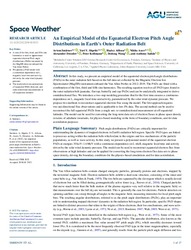An Empirical Model of the Equatorial Electron Pitch Angle Distributions in Earth's Outer Radiation Belt
Saikin, Anthony
DOI: https://doi.org/10.1029/2022SW003053
Persistent URL: http://resolver.sub.uni-goettingen.de/purl?gldocs-11858/10431
Persistent URL: http://resolver.sub.uni-goettingen.de/purl?gldocs-11858/10431
Supplement: https://doi.org/10.5880/GFZ.2.7.2022.001
Smirnov, Artem; Shprits, Yuri Y.; Allison, Hayley; Aseev, Nikita; Drozdov, Alexander; Kollmann, Peter; Wang, Dedong; Saikin, Anthony, 2022: An Empirical Model of the Equatorial Electron Pitch Angle Distributions in Earth's Outer Radiation Belt. In: Space Weather, Band 20, 9, DOI: 10.1029/2022SW003053.
 |
Dokument öffnen: |
In this study, we present an empirical model of the equatorial electron pitch angle distributions (PADs) in the outer radiation belt based on the full data set collected by the Magnetic Electron Ion Spectrometer (MagEIS) instrument onboard the Van Allen Probes in 2012–2019. The PADs are fitted with a combination of the first, third and fifth sine harmonics. The resulting equation resolves all PAD types found in the outer radiation belt (pancake, flat‐top, butterfly and cap PADs) and can be analytically integrated to derive omnidirectional flux. We introduce a two‐step modeling procedure that for the first time ensures a continuous dependence on L, magnetic local time and activity, parametrized by the solar wind dynamic pressure. We propose two methods to reconstruct equatorial electron flux using the model. The first approach requires two uni‐directional flux observations and is applicable to low‐PA data. The second method can be used to reconstruct the full equatorial PADs from a single uni‐ or omnidirectional measurement at off‐equatorial latitudes. The model can be used for converting the long‐term data sets of electron fluxes to phase space density in terms of adiabatic invariants, for physics‐based modeling in the form of boundary conditions, and for data assimilation purposes. Plain Language Summary:
Pitch angle distributions (PADs) are critically important for understanding the dynamics of trapped electrons in Earth's radiation belt region. Specific PAD types are linked to processes acting within the radiation belts which relate to the origins and loss mechanisms of the particle populations, as well as wave activity. In this study we present a polynomial model of the equatorial electron PADs at energies 30 keV–1.6 MeV with a continuous dependence on L‐shell, magnetic local time and activity driven by the solar wind dynamic pressure. The model can be used to reconstruct equatorial electron flux from observations at high latitudes and can be applied for converting the long‐term electron flux data sets to phase space density, driving the boundary conditions for the physics‐based simulations and for data assimilation. Key Points:
A sum of the first, third, and fifth sine harmonics is used to approximate equatorial electron Pitch angle distributions (PADs) measured by the MagEIS detector onboard the Van Allen Probes.
We present a PAD model with a continuous dependence on L, magnetic local time and activity, driven by the solar wind dynamic pressure.
The model allows reconstructions of equatorial PADs from uni‐ and omni‐directional measurements at off‐equatorial latitudes.
Statistik:
ZugriffsstatistikSammlung:
This is an open access article under the terms of the Creative Commons Attribution‐NonCommercial License, which permits use, distribution and reproduction in any medium, provided the original work is properly cited and is not used for commercial purposes.

